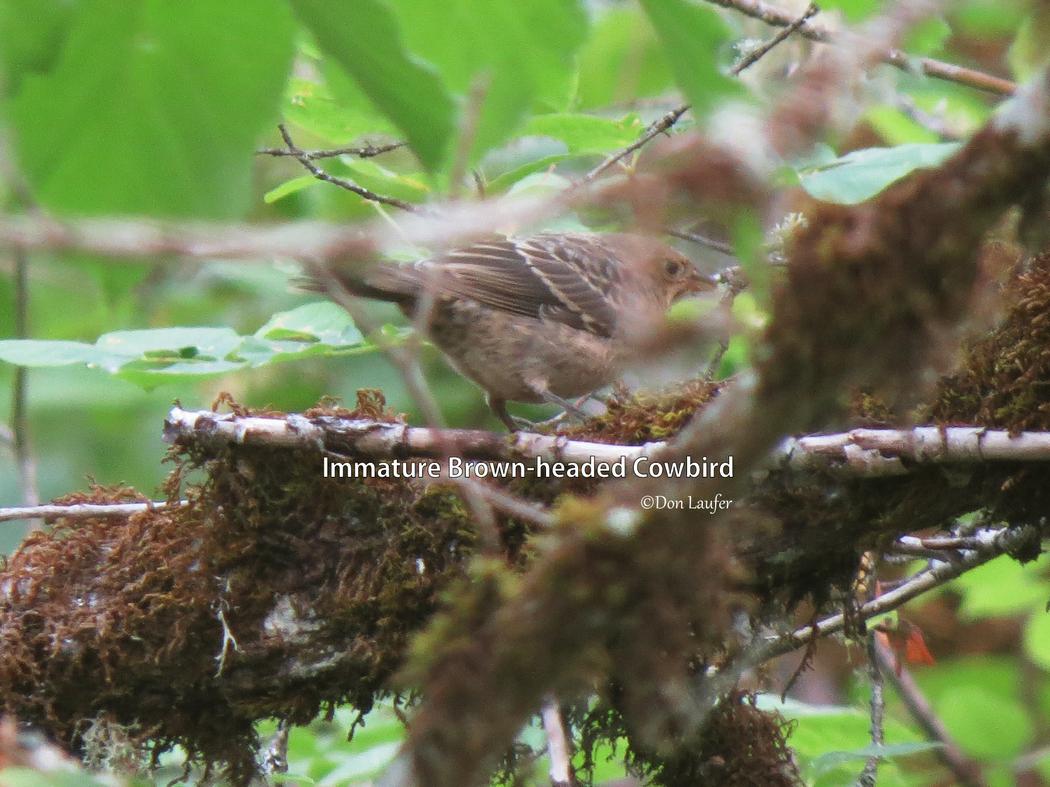We had another nice turnout on this beautiful, refreshingly cool morning. Morning clouds kept the temperature from rising until the last half hour or so.
About fifteen people showed up. Most were already there when the four of us who met for car-pooling at Campbell Center, arrived at Clearwater.
Our plan was to walk downstream along the river bank, where there is a dirt trail, because that was the location Scott McNeeley marked on his eBird report to indicate
where Red-eyed Vireos had been seen and heard a few weeks ago. (see at right and click to enlarge if desired).
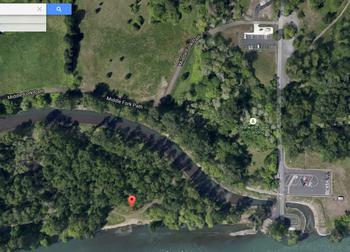
For the first hour of the walk, it was looking as though the Spotted Towhee was going to be the most common bird of the day. It may in fact still have turned out that way




No sooner had we seen the Spotted Towhee, someone saw a Spotted Sandpiper along the edge of the river. At the same time, a flock of American Goldfinches and a flock of Western Tanagers
were seen, along with a Rough-winged Swallow. We could have gone home right then and already had a respectable list of birds for only about 15 minutes of birding.
Conspicuously absent was the call of the Red-eyed Vireo. This was only conspicuous because that was the species which had brought us to this particular clearing along this particular trail.
No matter though. Plenty of time left and more trail to explore, though we had no idea how much or how little trail lie ahead. I wasn't expecting it to go far.
After enjoying the action in the clearing, we ventured ahead into a wooded area. All of this area probably gets a foot or several feet of water running through it when the Willamette river
runs high, as it does nearly every Winter once or twice. Consequently there are lots of grasses and younger trees, and not too many larger, older trees. There are plenty of shallow
channels, now dry, which probably carried out the last of the floodwaters each winter. Along these were small grassy openings in the woods.
This was a new trail for most of us and I heard many comments about how much people were enjoying this area, with its varied habitat.

There were quite a few birds singing in the wooded and meadow areas and we could identify some of them; Robin, perhaps Western Tanager, Western Wood Pewee,
Black-headed Grossbeak, as well as the ceaseless sounds of the Spotted Towhee. In one of the first woodland patches, we saw a young bird which may have been a Brown-headed Cowbird,
or else it may have been a young Western Tanager. In either case, two adult Tanagers were feeding it.
We all spent some time following the movements of this small Western Tanager family through the low trees and bushes.
Some had a few nice clear looks but mostly it was a peek-a-boo game, as Don's photo below demonstrates.
Of course there were woodpeckers too.
Several Downy and Hairy Woodpeckers were seen. And there were Red-breasted Sapsuckers as well.
When the Wednesday morning birding group birded here a few weeks back, Larry McQueen posted to OBOL that they had heard and seen the Red-eyed Vireo,
(though not the Chestnut-sided Warbler which had been reported. This bird lives east of the Rocky Mtns). Regarding the ubiquitous Red-breasted Sapsuckers,
he commented: "This woods ought to be called ‘Sapsucker Woods’ as an echo to Cornell’s. Sapsuckers here are prominent. "
My favorite picture from this trip is Don's photo of the juvenile Red-breasted Sapsucker. I love this birds "blood-rust" colored face.
After several wooded patches and several more open areas, we came to the millrace. From there we could see the bike path over on the other side of it. That bike path
is the one we usually take for Clearwater Landing bird walks. It is a five mile path which connects to Dorris Ranch.
On the trail section along the Millrace, walking West, a Common Yellowthroat was singing loudly for most if not all of the time we were out there. I cannot recall any Yellowthroat
singing so loudly. In spite of giving this bird some attention, few of us got more than a brief glimpse of it flitting about in the thickest part of a nearby tree. Although outdone by the Yellowthroat's song, a Western Wood Pewee contributed
perhaps an equal sense of presence, although visual rather than auditory; with its repeated appearances atop some bare branch tips of a short tree. We did get some photos.

This first photo of the Western Wood Pewee comes from Betsy. Of all the photos three or four of us took that day, this one best shows the classic head profile of a Flycatcher,
which is an excellent fieldmark for Flycatchers. In most of these photos of the Pewee, at least some hint of the orange color of the lower mandible can be seen.
The shape and thickness of the typically Flycatcher bill can also be seen.


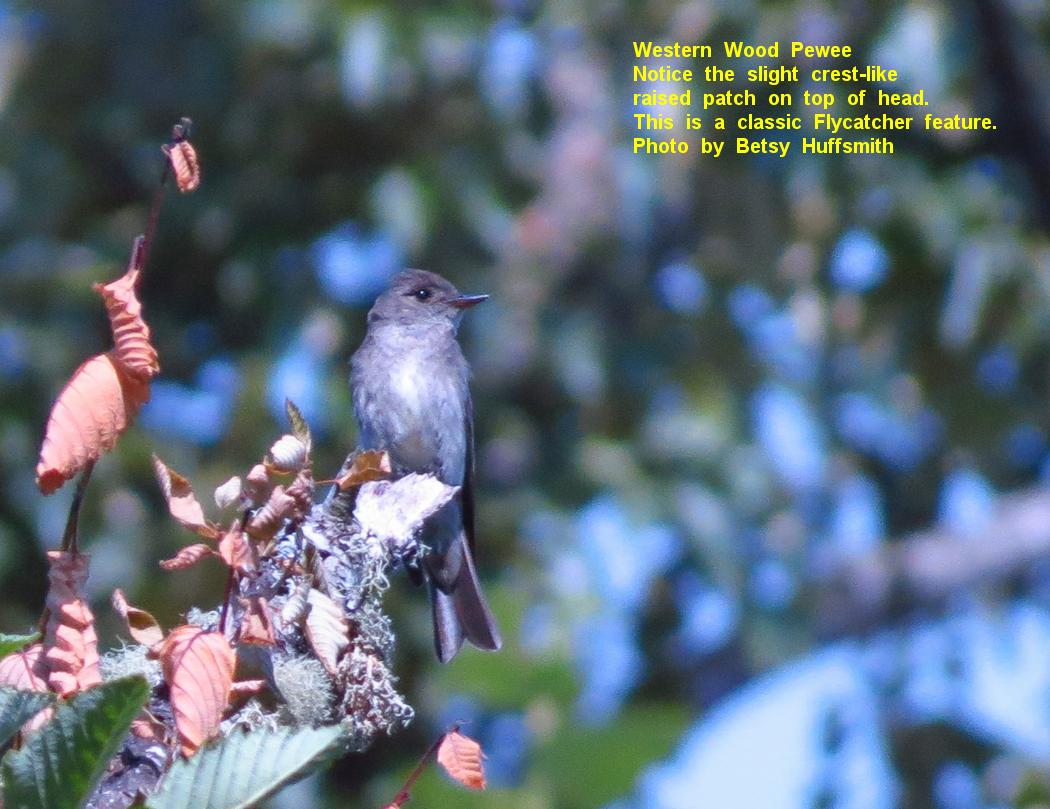




Last Summer at Clearwater Landing, we photographed a Willow Flycatcher. We were hearing its two-syllable call at the time, too. The next picture is a collage
made with two shots of that Willow Flycatcher and one of the Western Wood Pewee we saw on this current trip. The lesson learned
last year was to look carefully at how far the wings of the perched bird extend beyond the rump and along the tail. The wings of the Willow Flycatcher
only reach to the rump, while those of the Pewee extend almost 1/3 of the way down the length of the tail.
I am imagining some of you might be saying that these birds look so different that you would not confuse them anyway. While a few still photos might give that impression,
let me remind you how variable birds can be in their appearance, especially in different lighting conditions.
Those two photos of the Willow Flycatcher in this collage,
were taken only minutes apart, yet look at how different it appears. Not only that, but in field guides, Willow Flycatchers are shown having the classic Flycatcher head profile seen in the earlier
Western Wood Pewee photo (above), yet in these two photos, there is only a small indication of a crest-like area and only on one of them.
Also, regarding variable appearances, the particular Pewee in the collage is quite dark on the breast compared to some Pewees. I find their breast coloration to be highly variable.
By the way, I posted the Willow Flycatcher photos in this collage to OBOL last Summer to ask for help in identifying the bird
because in our group there was some uncertainty about it maybe being a Western Wood Pewee. There was no disagreement among the experts


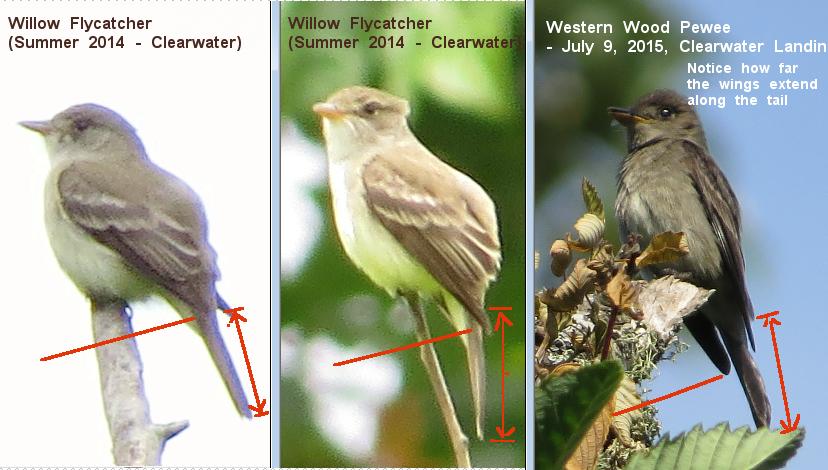

Along the Millrace, we saw more Goldfinches, more Waxwings, some Song Sparrows and a Western Fence Lizard. The lizard was basking in the Sun, (of course!) on a large rock
next to the stream.


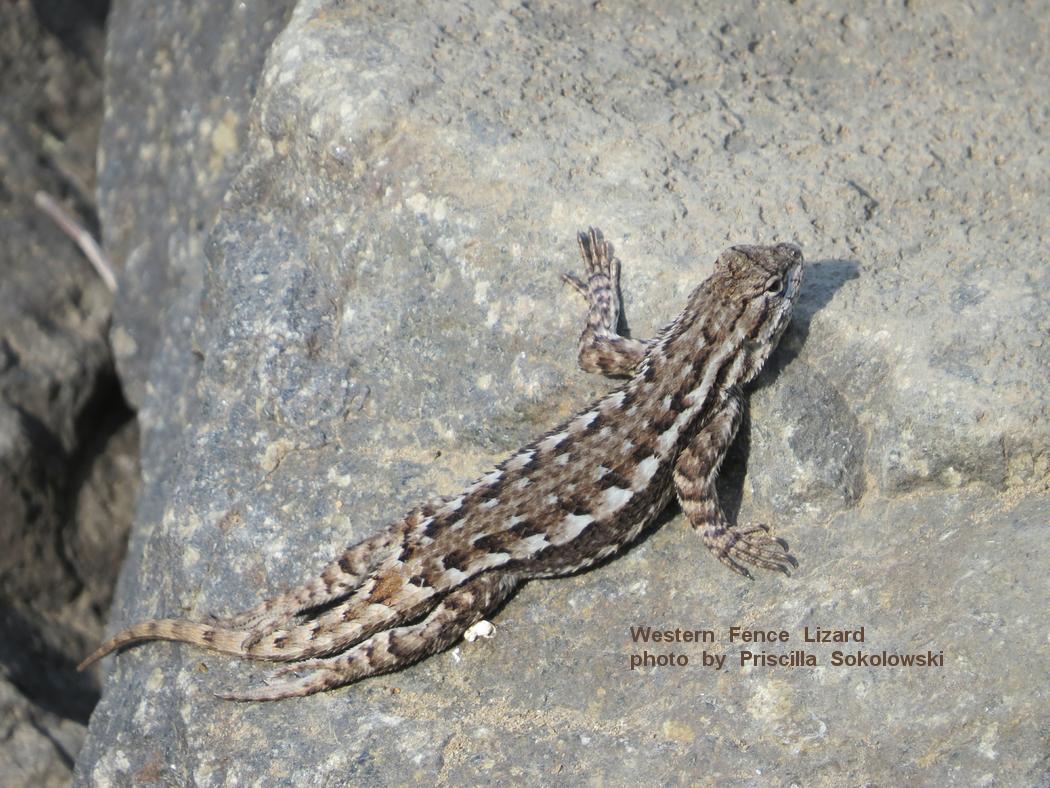

While we were at the far western end of trail along the Millrace, the clouds broke and the Sun came out. It started to feel warm pretty quickly,
though nearly everyone was wearing a hat of some kind. Until then, it had been such a perfect temperature and plenty of bright lighting.
As we got back into the wooded section, I saw a Robin with an insect in its beak and followed it with my binoculars as it went to a nest about 30 feet up a tree, where the trunk
branched.
A second adult Robin joined the first one, apparently feeding young bird which were out of sight in the nest. I tried to show others where the nest was, but only one or two
people were able to find it. There wasn't much to see really unless one of the adults were visible up there. I forgot to change the ISO on my camera to a higher number
to compensate for the lower lighting in the woods, to my photos of the Robins are blurry.





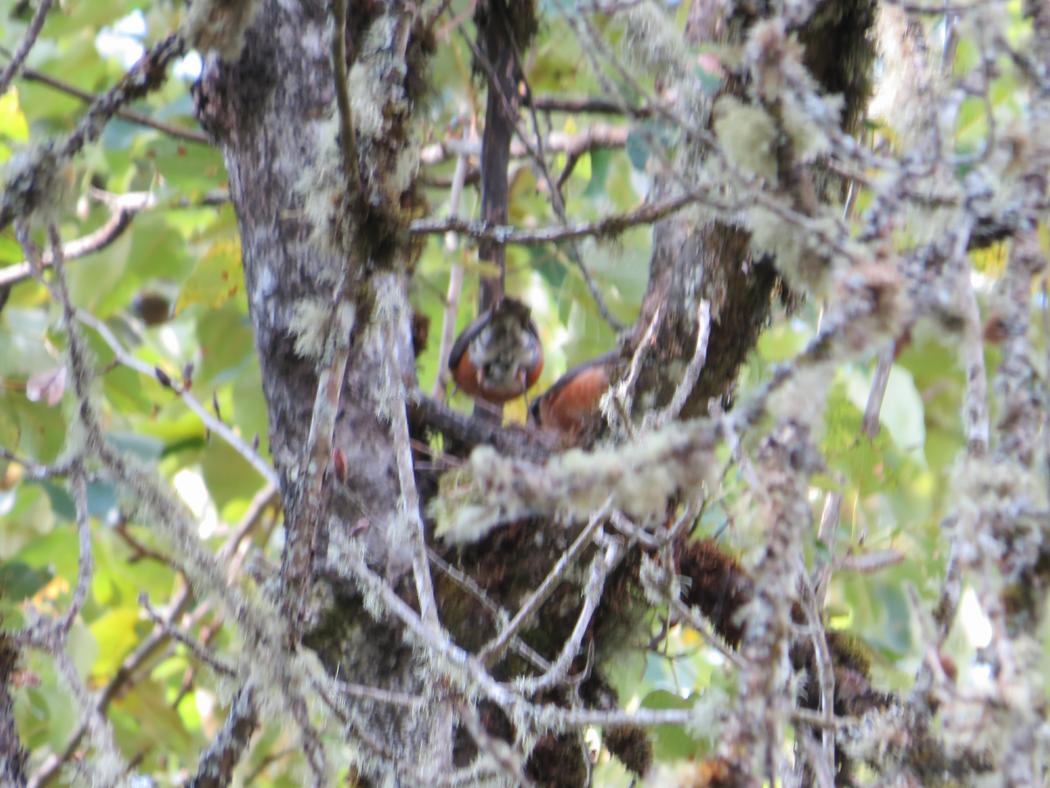





Also on the way back, Donna heard a bird song which was unfamiliar to her. Betsy recorded it. Their plan was to play the recording for Dan and/or Barbar Gleason at the Wild Birds Unlimited
store to see if they could identify the song. Since then, Betsy has informed me that the recorder was only good for voices up close. Perhaps Donna was able to sing a good imitation
of the bird's song for them.

While re-reading what Larry McQueen had posted on OBOL about the Wednesday morning birding groups experience at this site, I noticed he mentioned
that their group had not gone the direction we went when they got to the Millrace. They had turned right (east) and gone upstream. He wrote that
they came across a pond in a wooded area up there. That is where he made the comment that this wooded area should be named "Sapsucker Woods"
because of how many Red-breasted Sapsuckers his group saw there.
The next time we go out there, we will include that bit of the trail on our bird walk.
As we approached the parking lot several of us talked about where else we might go birding this Summer. One person mentioned that they really liked Hileman County Park,
which is a favorite of mine as well. We probably will include Hileman in our plans this Summer.
Another person suggested Elijah Bristow Park, which I have also long enjoyed, (back as far as the mid-80s). We decided that we might go to Elijah
Bristow on July 23, if it isn't too hot and if there are no large group events taking place there on that day. I have since checked the Park's calendar and they have nothing posted for July.
As for the weather, today, (Sunday July 19) is in the 90s, but predictions are for something closer to 80 by Thursday, so that looks promising.

I will post some driving directions on the updates page a day or two before the bird walk.
Here is a link to the map posted on the Elijah State Park website:
Bird list for walk along river bank trail at Clearwater Landing, July 9, 2015.
The weather was comfortably cool and cloudy for most of the time; then sunny and warmer.
I am not aware of anyone keeping a bird list during this walk. These are the birds I saw or heard people talking about seeing. I am sure I missed a half-dozen species.
-- compiled by Priscilla
- Rough-winged Swallow
- Spotted Sandpiper
- Robin
- Osprey
- Western Tanager
- American Goldfinch
- Western Wood Pewee
- Cedar Waxwing
- White-spotted Towhee
- Common Yellowthroat
- Common Yellowthroat
- Black-headed Grossbeak
- Hairy Woodpecker
- Red-breasted Sapsucker
- Brown-headed Cowbird
- Song Sparrow
- Bewick's Wren (heard)
- Unknown, (not a flycatcher) - heard only
The photo slide-show for this trip can be found here:
http://priscillanhk.com/bogs-summer-clearwater-7-9-15.html
Generally if you want to know what is happening next at BOGS, or want to see the latest photos/reports,
you can find these on my "updates" page:
http://priscillanhk.com/updates.html
Enjoy!
Priscilla









